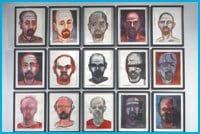The Museum of Contemporary Canadian Art (MOCCA) on Queen West is currently celebrating Andy Fabo with a survey of his multimedia work — the first of its kind in Toronto — that unearths his love of art history, metaphor and men through video, digital collage, drawing and painting.
Several works in this retrospective savour the tragic and erotic power of the body. Fabo’s hunger and desire for men is complicated from witnessing an immense loss — friends, lovers and colleagues ravaged by AIDS. Fabo’s tender images pay homage to history without simply surrendering to it. Heads is a series of 20 portraits that depicts a man’s face disintegrating from clarity to abstraction. This series of portraits is of Fabo’s partner of 15 years, Michael Balser, opening a window into Fabo’s mind as he watches someone dearly loved fade into memory. Balser died of AIDS in 2002. It is a profound series of drawings that speaks to the fragility of life and authority of personal strength.
Aphasia is an installation of drawings comprised of more than 300 pieces. Each drawing whispers its grief and rage while Fabo turns free associative lines and subjects into a scream of creative energy. Some pieces are whimsical and playful, while others are black drags of ink licking the page. Fabo manoeuvres text and image throughout, forming metaphors exulting in both joy and pain.
The complexity of Fabo’s relationship to the world includes the subject of death but is not bound to it. This survey takes on the difficult challenge of examining the idea of change through loss by invoking the possibility of transformation.
Born and raised in Calgary, Fabo attended the University Of Calgary and the Alberta College Of Art before moving to Toronto in 1975. He has been an invaluable creative force in Toronto’s art scene for many years, working with collectives such as ChromaZone, Homogenuis and dozens of queer art projects.
The show excavates both the recent and distant past of the artist’s identity. In a section called Selected Drawings From 1980-1992, one wall is dedicated to tracing history. Each piece hovers on the wall; hung in salon-style with mismatched frames, these drawings set the tone for the rest of the show. Selected Drawings is the antithesis of minimal as images of aroused men in formal compositions cover the white wall — drawings of patterned designs, naked men and loosely drawn game boards of snakes and ladders. Floating above it all is a small handmade doll. Tacked high on the wall, the knowing eyes peer out from his handsome face — it is Fabo’s grandfather watching over the room like a guardian. Selected Drawings charge Fabo’s Hungarian roots and folk art traditions with homoerotic sexuality in a way that is inflamed and moving.
Fabo depicts another lineage — his love of classical art and sexuality — in Laocoön Revisited, the most colourful canvas in the show. His subjects are amorous faggots with sword-like hard-ons that spill over with lust. Slices of vermillion red bumping against jade make this piece impossible to miss. Inspired by the famous Hellenist sculpture Laocoön And His Sons, the painting features three cajoling men with snakes that slip around their naked bodies. They look at us wildly aware of their arousal in what seems to be a deliberate tease to the viewer. It is as erotic as it is fetishistic, and reminds us that art and art history can be sexy.
There is a naïveté in Fabo’s work, not in its content but in its technique. Figures seem fastened to the background as they intentionally avoid obvious reality, much like the difference between live theatre and film. In a closed-off room where two videos are projected hangs a massive drawing whose figures shy away from realism, staying close to the surface of the paper. The bold gestural lines are reminiscent of Matisse’s Circle Of Life, but these subjects are not asexual, they are uncircumcised buff studs, delighting themselves in each other’s company.
Fabo’s pop art-influenced Time Machine is hand-painted and silk-screened pieces that bounce with humour. They are heavily layered, looking back in time yet, mischievously, pointing to the here and now. With images regurgitated from media these pieces become what Fabo describes as, “being refed a lived experience,” encapsulating Fabo’s engagement with contemporary culture.
Curator David Liss cleverly shows the growth of an artist as well as changes to our queer landscape. Liss has compiled a survey show that pays heed to arts activism by acknowledging the past while remaining keenly aware of the present. The Andy Fabo exhibition reveals a liberated and painful queer history that defiantly refuses ever to give up.

 Why you can trust Xtra
Why you can trust Xtra


